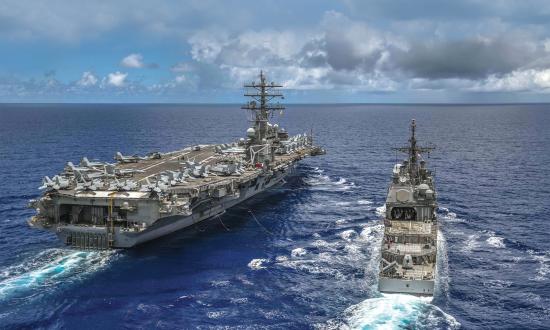The International Navies issue is one of my favorites every year, perhaps because it reminds me of some of the best moments of my Navy career—opportunities to exercise and operate with allied and partner navies. This month, we have 28 foreign navy chiefs writing for the International Commanders Respond section—the highest number ever. We asked them: “Given that every navy must deal with finite budgets and resources, how has your navy found the right balance between force size and force capability in terms of modern technology?” Here are their responses.
While we have a dedicated monthly column called “Need to Know,” there are two stand-alone articles this month that certainly fit that description. “China's Dual Command at Sea,” by Navy Captain Jeff Benson and Zi Yang, describes the bifurcated and parallel command structure that exists in all Chinese People’s Liberation Army (PLA) units, including PLA Navy ships. The fact that the political commissars are coequal with the commanding officers shows the extent of the Chinese Communist Party’s control over every facet of military operations. Nothing like this exists in the U.S. Navy, but the close interactions and increasing friction between the U.S. and PLA navies demands that we fully understand this dynamic. The other “must read” article on the PLA this month is retired Navy Commander Mike Dahm’s “China’s Desert Storm Education," which describes what the PLA learned from Operation Desert Storm. Over the past five years, Proceedings has dedicated a lot of “ink” to the Chinese military’s rapid development, but it still is hard to believe how quickly the PLA advanced from where it was in 1991 to where it is now. The lessons Beijing took from Desert Storm drove much of that modernization.
A few years ago, the U.S. Navy reestablished Second Fleet and NATO established Joint Forces Command (JFC) Norfolk. Both are tasked with dealing with a resurgent Russia’s increased naval activity in the North Atlantic and the Arctic. Vice Admiral Andrew Lewis, U.S. Navy, is the commander of both organizations, and he explains how Second Fleet and JFC Norfolk are adapting in “Strengthen the TransAtlantic Alliance." Retired Captain Chris Bott’s “Responding to Russia’s Northern Fleet” provides more details on those Russian challenges.
Last year, we asked retired U.S. Navy Captain Jim Fanell, retired Indian Navy Rear Admiral Sudarshan Shrikhande, and Combat Fleets of the World author Eric Wertheim to write about naval developments in Asia, the Indian Ocean region, and NATO countries. All three are back this year. Jim Fanell’s “'Ocean-oriented Strength' in a Time of Pandemic” describes the 2020 highlights of the PLA Navy. Admiral Shrikhande points out that “a taut watch . . . will remain very helpful in keeping the peace” in “An Unsettled Indian Ocean." And Mr. Wertheim’s “NATO 2020: Year in Review” provides an overview of all the shipbuilding and modernization programs of NATO nations’ navies.
This month’s Leadership Forum is the winning essay from our 2020 Leadership Essay Contest, sponsored by the late Dr. J. Phillip London and CACI International. F/A-18 Super Hornet pilot Lieutenant Jeff Zeberlein, U.S. Navy, looks back on the COVID-19 outbreak on the USS Theodore Roosevelt (CVN-71) last spring and gleans valuable lessons for leaders at all levels. He advises leaders to discern between well-intentioned mistakes and malice and to build trust so junior personnel will not fear reprisal when delivering bad news.
The American Sea Power Project will resume next month in the April Expeditionary Warfare issue.





